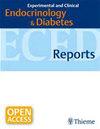糖蛋白非转移蛋白B (GPNMB):溶酶体与肥胖之间缺失的一环
IF 1.7
4区 医学
Q4 ENDOCRINOLOGY & METABOLISM
引用次数: 0
摘要
由于不健康的饮食和有限的身体活动,肥胖已经成为世界范围内的普遍流行病,并且是心血管疾病发展的重要预测因子。肥胖通常以白色脂肪组织(WAT)的促炎环境为特征,主要是由于巨噬细胞浸润增加。这些免疫细胞通过积累死亡脂肪细胞的含量来提高脂质浓度。由于溶酶体高度参与脂质处理,进行性脂质积累可能导致溶酶体应激和代谢转变。最近的研究发现糖蛋白非转移性黑色素瘤蛋白B (GPNMB)是炎症性疾病的新标志物。GPNMB是一种I型跨膜蛋白,存在于巨噬细胞、树突状细胞、成骨细胞、小胶质细胞等多种细胞表面,可被蛋白水解裂解为可溶性分子。它是由溶酶体应激通过小眼相关转录因子诱导的,因此在许多溶酶体储存疾病中被发现上调。此外,GPNMB与肥胖之间的明确联系最近被确立。在大多数情况下,GPNMB显示出保护和抗炎作用,防止肥胖相关代谢紊乱的进展。相比之下,可溶性GPNMB可能具有相反的作用,并促进WAT中的脂肪生成。本综述旨在总结和阐明GPNMB在肥胖进展中的作用,并强调其作为脂质相关疾病生物标志物的潜在用途。本文章由计算机程序翻译,如有差异,请以英文原文为准。
Glycoprotein Non-Metastatic Protein B (GPNMB): The Missing Link Between Lysosomes and Obesity
Abstract As a result of an unhealthy diet and limited physical activity, obesity has become a widespread pandemic worldwide and is an important predictor for the development of cardiovascular disease. Obesity is often characterized by a pro-inflammatory environment in white adipose tissue (WAT), mainly due to increased macrophage infiltration. These immune cells boost their lipid concentrations by accumulating the content of dying adipocytes. As the lysosome is highly involved in lipid handling, the progressive lipid accumulation may result in lysosomal stress and a metabolic shift. Recent studies have identified glycoprotein non-metastatic melanoma protein B (GPNMB) as a novel marker of inflammatory diseases. GPNMB is a type I transmembrane protein on the cell surface of various cell types, such as macrophages, dendritic cells, osteoblasts, and microglia, from which it can be proteolytically cleaved into a soluble molecule. It is induced by lysosomal stress via microphthalmia-associated transcription factor and thus has been found to be upregulated in many lysosomal storage disorders. In addition, a clear connection between GPNMB and obesity was recently established. GPNMB was shown to have protective and anti-inflammatory effects in most cases, preventing the progression of obesity-related metabolic disorders. In contrast, soluble GPNMB likely has the opposite effect and promotes lipogenesis in WAT. This review aims to summarize and clarify the role of GPNMB in the progression of obesity and to highlight its potential use as a biomarker for lipid-associated disorders.
求助全文
通过发布文献求助,成功后即可免费获取论文全文。
去求助
来源期刊
CiteScore
4.10
自引率
5.60%
发文量
72
审稿时长
3 months
期刊介绍:
Publishing outstanding articles from all fields of endocrinology and diabetology, from molecular biology to clinical research, this journal is a brilliant resource. Since being published in English in 1983, the popularity of this journal has grown steadily, reflecting the importance of this publication within its field.
Original contributions and short communications appear in each issue along with reviews addressing current topics. In addition, supplementary issues are published each year presenting abstracts or proceedings of national and international scientific meetings.
The journal was initially published in German and is still the oldest endocrinological periodical in the German-language market!

 求助内容:
求助内容: 应助结果提醒方式:
应助结果提醒方式:


